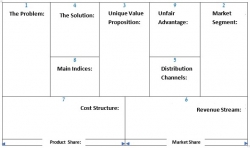Even in a Chaotic and Ever-Changing World it's Better to Work with a Plan and React to Changes
We're nearing the end of 2019, have you prepared a work-plan (and budget) for 2020? Maybe you have a three-year or five-year plan?
If the answer is no – this is the last chance to do so.
And maybe you think work plans aren't necessary?
The Way to an Adventurous Vacation
Let's say you live in the far north, and you want to go on vacation in the south. You're not sure where exactly, but you want a change, "to shake things up", to see new places. Your goal isn’t clear to you, nor is your destination.
But you want to be on the move. You go to the nearest bus station and get on the first bus that pulls in. Or maybe even hitch-hike and "go with the flow".
You can't predict where you'll be in an hour, tomorrow, in a week or in a month. You'll do whatever luck and circumstances dictate. Your ability to influence results will be low.
The Way to a Scheduled Vacation
Alternatively, you'll decide on a destination before you leave. For example, Eilat. You check the bus schedule, order a ticket for the bus to Eilat, maybe take a train part of the way, maybe fly part of the way.
The first option could be interesting, adventurous, you could meet new friends – but you're guaranteed to have less control over the outcome. You'll deal with whatever comes your way, whoever comes your way, and in fact the way you live your life during that time will be dependent on people and events that'll come along. You will be reacting to them.
The end result of the second option will be clearer. You'll be in control of the events and yourself. Naturally, some unexpected things will happen and you'll react to them on your way.
Running a Business – Which Way?
The first way could be good if you're looking for a change in life, or for inspiration.
But I wouldn’t recommend it as a way to run a business. It has too many pitfalls. You could lose your investment, or lose money in day-to-day business.
How can you decide whether or not to make an investment for the business if you don’t have a goal? In order to achieve your business goals you should, first, have business goals.
Do You Have Measurable Goals?
Do you have a goal? Have you set measurable goals for your business, or yourself? Travelling from the very north of Israel to Eilat can take between five to ten hours, depending on the way you choose to travel.
Achieving business goals takes longer.
So you should set goals and prepare a work-plan, for three to five years.
If your plan covers a few years, you'll be able to achieve bigger goals. Goals which take longer.
Remember, working without a plan, is like going on a trip without a destination or a schedule. You could come across many obstacles and be unprepared for unexpected events.
How to Prepare a Work-Plan for Upcoming Years?
A year ago I published an article called "Creating a Yearly Work-Plan – A Step-by-Step Guide". This present article is different, so I recommend you read the previous one.
First, let's start with a sales-plan, and accordingly build the action-plan for sales.
When we set a sales goal for an upcoming year, it should be close to sales numbers from the previous year. Approximately 5-10% more.
Development for following years should follow the same lines: every year, 5-10% more than the previous year.
But if we set a goal for three or five years from now, it will be ambitious. We'll than go back and set a series of yearly goals, until the present one.
We'll identify increases and work out ways to achieve them.
So, a sales plan should start with the farthest year. For example, if you're making a three-year plan, start with setting a sales goal for 2022. Then set a goal for 2021, and then for 2020.
Examine the development from the current year (2019) to the end-year of the plan (2022), and without changing the goal for 2022, work out a how to create the best development trajectory from now to then. This will dictate the goals for each year in the plan.
Before we get down to the details, let's look at setting a goal for the end-year. In this case, 2022.
Setting Your Business Strategy
It's best that the sales and development goals you set for the end-year be part of a wider plan. A part of your business strategy.
Over the last year I've written several articles dealing with strategy. Mostly about the Blue-Ocean strategy. Since building a business strategy isn't a simple task, I recommend you read those article before you make a work-plan (see links at the end of this article).
In brief, blue oceans are all the branches which don't yet exist. The unknown market. Red oceans are those areas where you compete with other companies to reach clients, or, at least, preserve existing ones.
Over time markets become inundated with competitors who offer the same product or service for a lower price, and the market gest crowded. The relentless competition makes the red ocean bloody.
In blue oceans, competition is irrelevant, since the rules of the game haven't been written yet. In order to achieve innovative thinking, you should gather as many ideas as possible. So I recommend you include as many people as possible in planning sessions: employees, managers, and stake-holders from outside the company.
A Sales-Plan – Step by Step
Once you've set a company strategy for following years, I recommend you follow these steps:
- Set a goal for the end-year (in this case, 2022).
- Divide this goal between your current market, which might be a red ocean, and sales which are part of a new strategy.
- Work backwards, to 2021 and 2020.
- For every year, divide the goal between the current market and the new strategy.
- For every year, set monthly sales goals. Take account of seasonal changes, if you're susceptible to them, like holidays and the likes.
- Examine the plan for the upcoming year (2020) in comparison to this year (2019). I recommend you build a continuous plan, without "jumps" from December of one year to January of the next year.
- When you plan "a jump" (progress), on a yearly scale, think how you'll achieve it. The farther the "jump" is, the better you can build the resources to achieve it. This is the advantage of long-term planning.
- Once you've an action-plan for sales, it's time to create a budget for it: for marketing, production, materials, labor costs and other production-related costs.
- Prepare an investment plan.
- And profit?
Two Ways to Look at Projected Profits: Traditional and Blue-Ocean
The first way is traditional: input all your data (sales numbers, material cost, marketing activity, management costs, general costs, etc.) to your existing profit model. That is, into a loss-profit report which will be very similar to your last one - and look at the results. Does it leave you with profit?
If not, you need to separate it to its different components and think about how you can make each one more efficient.
The second way is taken from the Blue-Ocean strategy, as is presented in the book Blue Ocean Strategy by Prof. W. Chan Kim and Prof. Renee Mauborgne, and has already been mentioned in a previous article. Look at the following chart:

With this model, you set a strategic price for products in blue ocean markets, and possible price for the rest. You also set a profit goal.
The innovation here is that cost isn't a constraint, but a variable
That is, while usually cost is a kind of constraint and the price and profit goals are variables which change according to it – here it is the opposite: the company sets a price and the desired profit, and accordingly finds creative ways to cut costs.
The authors write that in order to achieve the costs goal, a company has three options:
- Pricing innovation and efficiency, meaning to creatively bring about higher efficiency in production. The authors give the example of Swatch watches – they changed leather and metal components to plastic, and cut them back from 150 components to 51.
- Partnership, meaning having partners like sub-contractors in production, consultants, or other companies to assist with sales or with client implementation. This means the company focuses on its core activities while using specialized partners for other stages in the production chain.
- Innovation. When the above two options aren't possible, a company needs to innovate. For example, by changing the market. That is what Blockbuster did with video tape rentals.
Summary and Recommendations
In a survey of blog readers, 40% of participants answered that their company doesn’t work with a multi-year work-plan, and a further 20% answered that while their company prepares a work-plan, it isn’t followed.
This is also the reality I meet in many companies, where work-plans aren’t prepared or aren't followed, and challenges and unexpected events are handled (or attempts are made to handle them) as they arise.
In this article I showed the advantage of a multi-year work-plan.
- First, I recommend you build a business strategy. If you already have one, re-examine it in light of actual data and results, and refresh it.
- Second, set yearly measurable sales goals (starting with the farthest year in the plan).
- Third, create an action-plan to achieve sales goals.
- Budget for the necessary costs.
- In order to examine profits, follow one of two ways:
- The traditional way: input data (sales and costs) into the model of your last loss and profit report. Examine the results and work to improve if necessary.
- The Blue-Ocean way: as presented above. In this way, production costs are not a constraint but a variable.
Either way, make a work-plan for the up-coming year(s).
If you are interested in my professional help, personally or for your company, the best way to contact me is to send a request through the Get in Touch form here.
Relevant Articles:
• Creating a Yearly Work-Plan – A Step-by-Step Guide.
• Blue Ocean Sales Strategy.












 My First Book: Manage! Best Value Practices for Effective Management
My First Book: Manage! Best Value Practices for Effective Management